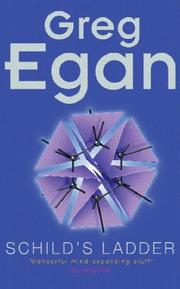
I’ve been cleaning up some of the old books I have scattered around my mother’s house. Some of these have been too damaged by poor storage conditions and need to be junked. Some others I’m too embarrassed to keep and will be donated. The rest needs to be packed up to be ready to be moved to Seremban. Greg Egan’s Schild’s Ladder is of course in that last category and while staying in Kuala Lumpur, I’ve found that my memory of it was poor enough to merit rereading the novel. Since I’ve never written about this particular book here as well, I thought I’d remedy that as well.
The Wikipedia entry for this novel calls it Greg Egan’s hardest SF book ever and considering that Egan is easily the hardest of the hard SF writers, this is a daunting statement indeed. This is because Schild’s Ladder begins with a fictional theory that unifies relativity with quantum mechanics, the so-called Sarumpaet rules of Quantum Graph Theory. In the far future universe of the novel, this has been the basic foundation of all physics for thousands of years even as humanity has spread out and diversified throughout the galaxy. Some of these descendents of humanity exist only as pure software constructs. The acorporeals as they are known aren’t even raised in an analogue of 3D space, preferring more complex spaces due to the belief that this will unnecessarily restrain the flexibility of their developing minds.
Others are more recognizably human, incorporating a biological body as a key component of their individual sense of self but even these are very alien to us, for example having no gender except as a vestigial reference to certain classes of names. But all are thrown into crisis when an experiment seeking to put the Sarumpaet rules to the ultimate test instead ends up creating a novo-vacuum, a pocket universe within which the laws of physics are drastically different. Beginning from a single point, this novo-vacuum expands inexorably at half the speed of light in all directions, engulfing worlds and entire systems. Six hundred years later, the novo-vacuum stretches across six hundred light years of space.
Civilization has adapted, either by fleeing again and again to ever more remote planets as the threat grows nearer or by permanently basing themselves on starships that constantly travel away from the novo-vacuum. Some dedicate themselves to studying the phenomenon and these base themselves on the Rindler, a starship that is programmed to stay close to the growing border by traveling at the same rate that the novo-vacuum is expanding. Over time, these researchers coalesce into two factions, the Preservationists, who seek to save the original universe and eradicate the novo-vacuum at almost any cost, and the Yielders, who feel that the novo-vacuum is a singular phenomenon that must be studied and that while the expansion may be checked, utterly destroying it would be a terrible waste.
Fans who know of Egan and his body of work will not be surprised that the good guys here are the Yielders, while the Preservationists are Luddites who seek to maintain the status quo and the mode of life that they are accustomed to regardless of how the universe changes around them. The novel is told through the point of view of Tchicaya, a Yielder who arrives on board the Rindler with many others in anticipation of the imminent destruction of the ancestral planet Earth. The conflict between the two factions threatens to turn ugly, undermining the civil and pacific nature of society that has held true ever since humanity left for the stars.
The overall theme here is rejection of nostalgia for its own sake and a call for sentient beings to be alive to and to embrace change when it’s needed rather than fight stubbornly against it. As one phrase in the book puts it, “If the ocean comes a few metres inshore, you retreat. A few kilometres, you build a dyke. A few thousand… you learn to live in boats.” To drive the point home, Egan even describes the anachronauts, who exist nowhere but in their own bodies and run on nothing but neural cells, as the ultimate villains of the story.
As a long-time fan of Egan, one of the most interesting things about this novel is that it offers a very rare portrayal of violent conflict in an utopian, far future scenario. All of his previous stories have always stressed that physical violence no longer exists because all intelligent beings recognize how pointless it is and how modern technologies and its safeguards have made it so that inflicting the tiniest amount of meaningful harm to another sentient being would take a Herculean effort, so no one actually bothers. Here, it’s presented because the anachronauts are too dumb to know any better and aren’t really part of civilized society anyway.
All the same, I’m frustrated that he doesn’t spend more time on the consequences of the conflict. At least one modern member of civilization collaborated with the anachronauts. How does the libertarian and utopian society deal with this? We never know because in a very Star Trek-like manner Egan prefers to focus on the wide-eyed wonder of exploration and the aesthetically beautiful principles of physics and mathematics than the nitty gritty details of how to get everyone to get along smoothly when everyone has different desires and values.
All said, this is a great SF novel and is loads better than his more recent works. Here’s to hoping that his new book The Clockwork Rocket, which is supposedly the first part of a trilogy, the first time he’s ever done something like this, is a return to this kind of form.